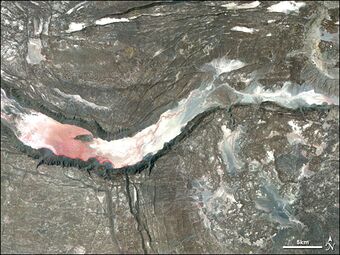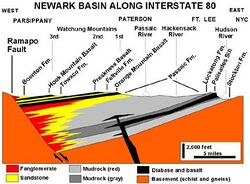Graben
Topic: Earth
 From HandWiki - Reading time: 5 min
From HandWiki - Reading time: 5 min
In geology, a graben (/ˈɡrɑːbən/) is a depressed block of the crust of a planet or moon, bordered by parallel normal faults.
Etymology
Graben is a loan word from German, meaning 'ditch' or 'trench'. The first known usage of the word in the geologic context was by Eduard Suess in 1883.[1] The plural form is either graben[2] or grabens.[3]
Formation
A graben is a valley with a distinct escarpment on each side caused by the displacement of a block of land downward. Graben often occur side by side with horsts. Horst and graben structures indicate tensional forces and crustal stretching.
Graben are produced from parallel normal faults, where the displacement of the hanging wall is downward, while that of the footwall is upward. The faults typically dip toward the center of the graben from both sides. Horsts are parallel blocks that remain between graben; the bounding faults of a horst typically dip away from the center line of the horst. Single or multiple graben can produce a rift valley.
Half-graben
In many rifts, the graben are asymmetric, with a major fault along only one of the boundaries, and these are known as half-graben. The polarity (throw direction) of the main bounding faults typically alternates along the length of the rift. The asymmetry of a half-graben strongly affects syntectonic deposition. Comparatively little sediment enters the half-graben across the main bounding fault because of footwall uplift on the drainage systems. The exception is at any major offset in the bounding fault, where a relay ramp may provide an important sediment input point. Most of the sediment will enter the half-graben down the unfaulted hanging wall side (e.g., Lake Baikal).[4]
Examples
Africa
- East African Rift Valley
- Lucapa Graben, Lunda Norte Province, Angola
Antarctica
Asia
- Narmada River Valley, central India
- lower Godavari River Valley, southern India
- Baikal Rift Zone, Siberia, Russia
- Moma Graben, Sakha Republic, Russia
- Büyük Menderes Graben, Turkey
- Fossa Magna, Honshu, Japan
- Ariake Sea as part of the Unzen graben, Kyushu, Japan
- Beppu–Shimabara graben, Kyushu, Japan
Europe
- Rhine valley, border area of west Germany and northeast France
- Oslo graben around Oslo, Norway
- Central Lowlands, Scotland
- Worcester Basin, England
- Central Graben, North Sea
- Viking Graben, North Sea
- Vättern, Sweden
- Lowtherville Graben, Ventnor, Isle of Wight, England[5][6]
North America
Canada
- Ottawa-Bonnechere Graben, Ontario and Quebec, Canada
- Saguenay Graben, Quebec, Canada
Guatemala
- Guatemala City valley, Guatemala
United States
- Basin and Range Province of southwestern North America is an example of multiple horst/graben structures, including Death Valley, with Salt Lake Valley being the easternmost and Owens Valley being the westernmost.
- Lake George Basin, New York, U.S.
- Lake Tahoe Basin, California and Nevada, U.S.
- Republic Graben, Republic, Washington (state) , U.S.
- Rio Grande Rift Valley in Colorado/New Mexico/Texas of the United States
- Rough Creek Graben, Kentucky, U.S.
- Santa Clara Valley, California , U.S.
- Western Snake River Plain, Idaho, U.S.
- Southwest San Bernardino Valley (Arizona), U.S.
Multi-national
- Eastern North America Rift Basins, Canada and the U.S.
- Midcontinent Rift System, Canada and the U.S.
- Salton Trough, Mexico and the U.S.
Oceania
- Firth of Thames of Hauraki Gulf and Hauraki Plains of Hauraki Rift (Hauraki half grabens), North Island, New Zealand[7]
- Tikitere Graben within the Taupō Rift, North Island, New Zealand.[8]
- Gulf St Vincent, South Australia, Australia [9]
- Tamar Valley, Tasmania, Australia[10]
South America
- Guanabara Graben, Rio de Janeiro, Brazil
See also
- European Cenozoic Rift System
- Earth:Fossa (geology)
Notes
- ↑ graben (3rd ed.), Oxford University Press, September 2005, http://oed.com/search?searchType=dictionary&q=graben (Subscription or UK public library membership required.)
- ↑ Schlumberger Oilfield Glossary
- ↑ "horst and graben". horst and graben. Encyclopædia Britannica. https://www.britannica.com/EBchecked/topic/272443/horst-and-graben. Retrieved 2012-11-15.
- ↑ Hans Nelson, C.; Karabanov, Evgeny B.; Colman, Steven M.; Escutia, Carlota (1999). "Tectonic and sediment supply control of deep rift lake turbidite systems: Lake Baikal, Russia". Geology 27 (2): 163–166. doi:10.1130/0091-7613(1999)027<0163:TASSCO>2.3.CO;2. Bibcode: 1999Geo....27..163N.
- ↑ CAREY, JONATHAN (2011). The Progressive Development and Post-failure Behaviour of Deep-seated Landslide Complexes (Doctoral thesis). Durham University.
- ↑ Carey, Jonathan (November 2014). "Patterns of movement in the Ventnor landslide complex, Isle of Wight, southern England". Landslides. https://www.researchgate.net/publication/284942330.
- ↑ Hochstein, M.P.; Nixon, I.M. (1979). "Geophysical study of the Hauraki Depression, North Island, New Zealand". New Zealand Journal of Geology and Geophysics 22: 1–19. doi:10.1080/00288306.1979.10422550.
- ↑ Manville, V.; Hodgson, K. A.; Nairn, I. A. (2007). "A review of break‐out floods from volcanogenic lakes in New Zealand". New Zealand Journal of Geology and Geophysics 50 (2): 131–150. doi:10.1080/00288300709509826. https://www.tandfonline.com/doi/pdf/10.1080/00288300709509826.
- ↑ Sprigg, R.C. (1961). "The Oil and Gas Prospects of the St. Vincents Gulf Graben". The APPEA Journal 1 (1): 71–88. doi:10.1071/AJ60011. http://www.publish.csiro.au/AJ/AJ60011.
- ↑ Stacey, A. R., and Berry, R. F., (2004). "The Structural history of Tasmania: a review for petroleum explorers," PESA Eastern Australasian Basins Symposium II
References
- McKnight, Tom L; Hess, Darrel (2000). "The Internal Processes: Graben". Physical Geography: A Landscape Appreciation. Upper Saddle River, NJ: Prentice Hall. pp. 417. ISBN 0-13-020263-0. https://archive.org/details/physicalgeographmckn/page/417.
 |
 KSF
KSF



